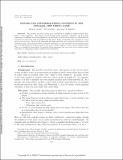Motors and Impossible Firing Patterns in the Parallel Chip-Firing Game
Author(s)
Zhang, Yan X.; Jiang, Tian-Yi D.; Scully, Ziv D.
DownloadMotors and impossible.pdf (491.2Kb)
PUBLISHER_POLICY
Publisher Policy
Article is made available in accordance with the publisher's policy and may be subject to US copyright law. Please refer to the publisher's site for terms of use.
Terms of use
Metadata
Show full item recordAbstract
The parallel chip-firing game is an automaton on graphs in which vertices “fire” chips to their neighbors. This simple model contains much emergent complexity and has many connections to different areas of mathematics. In this work, we study firing sequences, which describe each vertex's interaction with its neighbors in this game. First, we introduce the concepts of motors and motorized games. Motors both generalize the game and allow us to isolate local behavior of the (ordinary) game. We study the effects of motors connected to a tree and show that motorized games can be transformed into ordinary games if the motor's firing sequence occurs in some ordinary game. Then, we completely characterize the periodic firing sequences that can occur in an ordinary game, which have a surprisingly simple combinatorial description.
Date issued
2015-03Department
Massachusetts Institute of Technology. Department of MathematicsJournal
SIAM Journal on Discrete Mathematics
Publisher
Society for Industrial and Applied Mathematics
Citation
Jiang, Tian-Yi, Ziv Scully, and Yan X. Zhang. “Motors and Impossible Firing Patterns in the Parallel Chip-Firing Game.” SIAM Journal on Discrete Mathematics 29.1 (2015): 615–630. © 2015 Society for Industrial and Applied Mathematics
Version: Final published version
ISSN
0895-4801
1095-7146